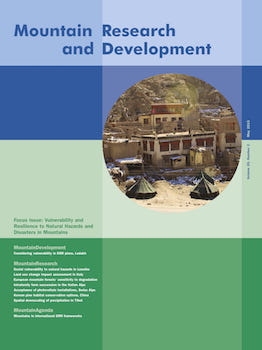Dear Readers,
As we were writing this Editorial, news from the devastating 25 April 2015 7.8 earthquake in Nepal reached us. In a few seconds, the reality of natural hazards exceeded the perception we had of the vulnerability of people living in mountains. What is addressed in this issue of MRD has become the brutal reality experienced by millions of people living in Nepal, among whom some of our authors, reviewers, and Editorial Board members. When you will read this Editorial, the event and its terrible aftermath will no longer be in the headlines. But this is precisely the moment when the people affected will most need long-term support. The broader perspectives on natural hazards taken by the authors in this issue of MRD are a small but justified contribution to improving prevention and recovery efforts.
This extremely sad event shows once again that mountains are high-risk areas for multiple hazards—including earthquakes in geologically young regions—and mountain people are increasingly exposed to natural disasters. Especially in the South, difficult social, economic, and political conditions heighten their vulnerability. Efforts to improve knowledge and action have been made in the last decades in research, policy, and practice: the science community, governments, development cooperation, and the private sector have tried to improve understanding of the processes and dynamics of natural hazards and disasters from a social-ecological perspective, and to reduce risks and enhance the resilience of mountain communities and mountain environments. But more needs to be done. In March 2015, the Hyogo Framework for Action: Building the resilience of nations and communities to disasters was replaced by the Sendai Framework for Disaster Risk Reduction 2015–2030, adopted in Japan at the international World Conference on Disaster Risk Reduction. How well are mountains and mountain people taken into account in these guiding international policy frameworks?
This question is addressed by M. Zimmermann and M. Keiler in their mountain-specific review of the state of the art on key international policy efforts to understand and tackle disaster risk reduction (DRR). In this MountainAgenda paper, updated with fresh results from Sendai and insights from mountain research, the authors argue that the frameworks offer useful guidance but need to be further adapted for the mountain context. This requires special attention for a number of reasons, in particular because of changing risk patterns under the impact of climate change and high land use pressure.
This need for local adaptation of international and national policy is also a concern in the first paper in the MountainDevelopment section, in which V. le Masson explores whether the progressive DRR approaches in Ladakh—which explicitly took up recommendations made in the Hyogo Framework—were effective after the catastrophic 2010 floods. She argues that “establishing policies does not guarantee that appropriate practices will follow” and illustrates how implementation of DRR policies can become more effective by taking into account the socioeconomic construction of risks and latent development obstacles (eg corruption), showing how DRR can be done with participation by the local population.
In the MountainResearch section, 3 additional papers address the focus of this issue as well. In the first, M. Letsie and S. Grab apply a well-known place-based social vulnerability index to Southern Lesotho, where quantitative data on vulnerability is sorely lacking; the results show that underdevelopment, poverty, and inaccessibility lead to high vulnerability in the rural highlands. In the second, Ž. Malek and L. Boerboom report on the results of participatory scenario development in a tourism area in the Italian Alps exposed to high hydro-meteorological risk; their method helps to overcome data inaccessibility and address external drivers. In the third, B. Reger et al use a GIS-based model for soil and canopy analysis to assess and map forest vulnerability in the Limestone Alps of Austria and Bavaria, which are increasingly affected by storms and bark beetle infestations, leading to loss of their protective function. Additional papers focusing on vulnerability and resilience to natural hazards and disasters are currently under review and will be published in future issues of MRD.
Further papers in the MountainResearch section deal with a variety of topics. D. Cavicchioli et al use statistical analysis to explore the influence of various factors on succession—an important condition for maintaining family farming in mountain areas—to assess the status of intrafamily farm succession in the Italian Alps. A. Michel et al analyze the social acceptance of photovoltaic installations on avalanche barriers in a Swiss Alpine region. Lin Ma et al map the effectiveness of habitat conservation in the Changbai area, northeastern China, using the C-Plan software; they show where effective planning of Korean pine conservation areas could help preserve a number of threatened species with minimal impact on economic activities. Finally, Yuli Shi and Lei Song propose a new approach to spatial downscaling of TRMM precipitation estimates using the Enhanced Vegetation Index (EVI) for the Tibetan Plateau.
We would like to express our deep sympathy to the people of Nepal. The memory of what happened will certainly increase our will to publish whatever useful work authors will submit that can help to alleviate the precariousness of people's livelihoods in mountains and enhance existing capacity to recover from such shocks.





